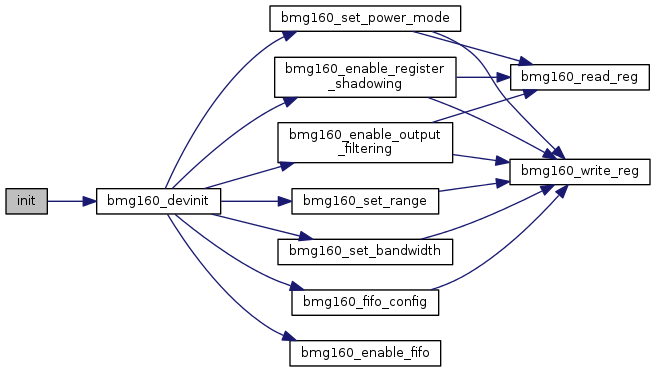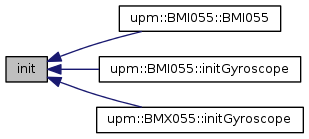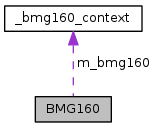|
upm
1.7.1
Sensor/Actuator repository for libmraa (v2.0.0)
|
|
upm
1.7.1
Sensor/Actuator repository for libmraa (v2.0.0)
|
API for the BMG160 16 bit Triaxial Gyroscope. More...
The BMG160 is a 3-axis angular rate sensor that is made of a surface micro machined sensing element and an evaluation ASIC. Both parts are packed into one single LGA 3.0mm x 3.0mm x 0.95mm housing. The BMG160 is designed to meet requirements for consumer applications such as image stabilization (DSC and camera-phone), gaming and pointing devices. It is capable to measure angular rates in three perpendicular room dimensions, the x-, y- and z-axis, and to provide the corresponding output signals. The BMG160 is fitted with digital bi-directional SPI and I2C interfaces for optimum system integration.
Not all functionality of this chip has been implemented in this driver, however all the pieces are present to add any desired functionality. This driver supports both I2C (default) and SPI operation.
This device requires 3.3v operation.
Public Member Functions | |
| BMG160 (int bus=BMG160_DEFAULT_I2C_BUS, int addr=BMG160_DEFAULT_ADDR, int cs=-1) | |
| ~BMG160 () | |
| void | update () |
| uint8_t | getChipID () |
| void | getGyroscope (float *x, float *y, float *z) |
| std::vector< float > | getGyroscope () |
| float | getTemperature (bool fahrenheit=false) |
| void | init (BMG160_POWER_MODE_T pwr=BMG160_POWER_MODE_NORMAL, BMG160_RANGE_T range=BMG160_RANGE_250, BMG160_BW_T bw=BMG160_BW_400_47) |
| void | reset () |
| void | setRange (BMG160_RANGE_T range) |
| void | setBandwidth (BMG160_BW_T bw) |
| void | setPowerMode (BMG160_POWER_MODE_T power) |
| void | enableFIFO (bool useFIFO) |
| void | fifoSetWatermark (int wm) |
| void | fifoConfig (BMG160_FIFO_MODE_T mode, BMG160_FIFO_DATA_SEL_T axes) |
| uint8_t | getInterruptEnable0 () |
| void | setInterruptEnable0 (uint8_t bits) |
| uint8_t | getInterruptMap0 () |
| void | setInterruptMap0 (uint8_t bits) |
| uint8_t | getInterruptMap1 () |
| void | setInterruptMap1 (uint8_t bits) |
| uint8_t | getInterruptSrc () |
| void | setInterruptSrc (uint8_t bits) |
| uint8_t | getInterruptOutputControl () |
| void | setInterruptOutputControl (uint8_t bits) |
| void | clearInterruptLatches () |
| BMG160_RST_LATCH_T | getInterruptLatchBehavior () |
| void | setInterruptLatchBehavior (BMG160_RST_LATCH_T latch) |
| uint8_t | getInterruptStatus0 () |
| uint8_t | getInterruptStatus1 () |
| uint8_t | getInterruptStatus2 () |
| uint8_t | getInterruptStatus3 () |
| void | enableRegisterShadowing (bool shadow) |
| void | enableOutputFiltering (bool filter) |
| void | installISR (BMG160_INTERRUPT_PINS_T intr, int gpio, mraa::Edge level, void(*isr)(void *), void *arg) |
| void | uninstallISR (BMG160_INTERRUPT_PINS_T intr) |
| uint8_t | readReg (uint8_t reg) |
| int | readRegs (uint8_t reg, uint8_t *buffer, int len) |
| void | writeReg (uint8_t reg, uint8_t val) |
Protected Attributes | |
| bmg160_context | m_bmg160 |
| BMG160 | ( | int | bus = BMG160_DEFAULT_I2C_BUS, |
| int | addr = BMG160_DEFAULT_ADDR, |
||
| int | cs = -1 |
||
| ) |
BMG160 constructor.
This device can support both I2C and SPI. For SPI, set the addr to -1, and specify a positive integer representing the Chip Select (CS) pin for the cs argument. If you are using a hardware CS pin (like edison with arduino breakout), then you can connect the proper pin to the hardware CS pin on your MCU and supply -1 for cs. The default operating mode is I2C.
| bus | I2C or SPI bus to use. |
| addr | The address for this device. -1 for SPI. |
| cs | The gpio pin to use for the SPI Chip Select. -1 for I2C or for SPI with a hardware controlled pin. |
| std::runtime_error | on initialization failure. |
| void update | ( | void | ) |
Update the internal stored values from sensor data.
| std::runtime_error | on failure. |


| uint8_t getChipID | ( | ) |
Return the chip ID.

| void getGyroscope | ( | float * | x, |
| float * | y, | ||
| float * | z | ||
| ) |
Return gyroscope data in degrees per second. update() must have been called prior to calling this method.
| x | Pointer to a floating point value that will have the current x component placed into it. |
| y | Pointer to a floating point value that will have the current y component placed into it. |
| z | Pointer to a floating point value that will have the current z component placed into it. |


| std::vector< float > getGyroscope | ( | ) |
Return gyroscope data in degrees per second in the form of a floating point vector. update() must have been called prior to calling this method.
| float getTemperature | ( | bool | fahrenheit = false | ) |
Return the current measured temperature. Note, this is not ambient temperature. update() must have been called prior to calling this method.
| fahrenheit | true to return data in Fahrenheit, false for Celicus. Celsius is the default. |

| void init | ( | BMG160_POWER_MODE_T | pwr = BMG160_POWER_MODE_NORMAL, |
| BMG160_RANGE_T | range = BMG160_RANGE_250, |
||
| BMG160_BW_T | bw = BMG160_BW_400_47 |
||
| ) |
Initialize the device and start operation. This function is called from the constructor so will not typically need to be called by a user unless the device is reset.
| pwr | One of the BMG160_POWER_MODE_T values. The default is BMG160_POWER_MODE_NORMAL. |
| range | One of the BMG160_RANGE_T values. The default is BMG160_RANGE_250. |
| bw | One of the filtering BMG160_BW_T values. The default is BMG160_BW_400_47. |
| std::runtime_error | on failure. |


| void reset | ( | ) |
| void setRange | ( | BMG160_RANGE_T | range | ) |
Set the gyroscope detection scaling range. This device supports 125, 250, 500, 1000, and 2000 degree/s ranges.
| range | One of the BMG160_RANGE_T values. |
| std::runtime_error | on failure. |

| void setBandwidth | ( | BMG160_BW_T | bw | ) |
Set the output filtering bandwidth of the device.
| bw | One of the BMG160_BW_T values. |
| std::runtime_error | on failure. |

| void setPowerMode | ( | BMG160_POWER_MODE_T | power | ) |
Set the power mode of the device. Care must be taken when setting a low power or suspend mode. See the datasheet for details. I ncertain power modes, register write must be drastically slowed down. which we cannot support.
| power | One of the POWER_MODE_T values. |
| std::runtime_error | on failure. |

| void enableFIFO | ( | bool | useFIFO | ) |
Enable update() to read from the FIFO rather than the gyroscope axis registers directly. init() enables this mode by default. An advantage to this mode that all axis data is sampled from the same timeslice. When reading directly from the gyroscope output registers, it's possible for one axis to be updated while another is being read, causing a temporal inconsistancy..
Using the FIFO removes this problem.
| useFIFO | true to enable update() to read from the FIFO. When false, update will read from the gyroscope output registers directly. |

| void fifoSetWatermark | ( | int | wm | ) |
Set the FIFO watermark. When the watermark is reached an interrupt (if enabled) will be generated.
| wm | The FIFO watermark to use. The maximum value is 63. |
| std::runtime_error | on failure. |

| void fifoConfig | ( | BMG160_FIFO_MODE_T | mode, |
| BMG160_FIFO_DATA_SEL_T | axes | ||
| ) |
Set the FIFO configuration. init() uses the BMG160_FIFO_MODE_BYPASS mode with axes set to BMG160_FIFO_DATA_SEL_XYZ by default.
| mode | One of the BMG160_FIFO_MODE_T values. |
| axes | One of the BMG160_FIFO_DATA_SEL_T values. |
| std::runtime_error | on failure. |

| uint8_t getInterruptEnable0 | ( | ) |
Return the Interrupt Enables 0 register. These registers allow you to enable various interrupt conditions. See the datasheet for details.

| void setInterruptEnable0 | ( | uint8_t | bits | ) |
Set the Interrupt Enables 0 register. See the datasheet for details.
| bits | A bitmask of BMG160_INT_EN_0_BITS_T bits. |
| std::runtime_error | on failure. |

| uint8_t getInterruptMap0 | ( | ) |
Return the Interrupt Map 0 register. These registers allow you to map specific interrupts to the interrupt 1 or interrupt 2 pin. See the datasheet for details.

| void setInterruptMap0 | ( | uint8_t | bits | ) |
Set the Interrupt Map 0 register. These registers allow you to map specific interrupts to the interrupt 1 or interrupt 2 pin. See the datasheet for details.
| bits | A bitmask of BMG160_INT_MAP_0_BITS_T bits. |
| std::runtime_error | on failure. |

| uint8_t getInterruptMap1 | ( | ) |
Return the Interrupt Map 1 register. See the datasheet for details.

| void setInterruptMap1 | ( | uint8_t | bits | ) |
Set the Interrupt Map 1 register. See the datasheet for details.
| bits | A bitmask of BMG160_INT_MAP_1_BITS_T bits. |
| std::runtime_error | on failure. |

| uint8_t getInterruptSrc | ( | ) |
Return the Interrupt source register. This register allows determining where data comes from (filtered/unfiltered) for those interrupt sources where this is selectable. See the datasheet for details.

| void setInterruptSrc | ( | uint8_t | bits | ) |
Set the Interrupt source register. This register allows determining where data comes from (filtered/unfiltered) for those interrupt sources where this is selectable. See the datasheet for details.
| bits | A bitmask of INT_1A_BITS_T bits. |
| std::runtime_error | on failure. |

| uint8_t getInterruptOutputControl | ( | ) |
Return the Interrupt output control register. This register allows determining the electrical characteristics of the 2 interrupt pins (open-drain/push-pull and level/edge triggering). See the datasheet for details.

| void setInterruptOutputControl | ( | uint8_t | bits | ) |
Set the Interrupt output control register. This register allows determining the electrical characteristics of the 2 interrupt pins (open-drain/push-pull and level/edge triggering). See the datasheet for details.
| bits | A bitmask of INT_EN_1_BITS_T bits. |
| std::runtime_error | on failure. |

| void clearInterruptLatches | ( | ) |
Clear all latched interrupts. See the datasheet for details.
| std::runtime_error | on failure. |

| BMG160_RST_LATCH_T getInterruptLatchBehavior | ( | ) |
Return the current interrupt latching behavior. See the datasheet for details.

| void setInterruptLatchBehavior | ( | BMG160_RST_LATCH_T | latch | ) |
Set the current interrupt latching behavior. See the datasheet for details.
| latch | One of the RST_LATCH_T values. |
| std::runtime_error | on failure. |

| uint8_t getInterruptStatus0 | ( | ) |
Return the interrupt status 0 register. These registers indicate which interrupts have been triggered. See the datasheet for details.

| uint8_t getInterruptStatus1 | ( | ) |
Return the interrupt status 1 register. See the datasheet for details.

| uint8_t getInterruptStatus2 | ( | ) |
Return the interrupt status 2 register. See the datasheet for details.

| uint8_t getInterruptStatus3 | ( | ) |
Return the interrupt status 3 register. See the datasheet for details.

| void enableRegisterShadowing | ( | bool | shadow | ) |
Enable shadowing of the gyroscope output registers. When enabled, a read of an axis LSB register automatically locks the MSB register of that axis until it has been read. This is usually a good thing to have enabled. init() enables this by default. If disabled, then it becomes possible for part of an axis value to change while another part is being read, causing inconsistent data.
| shadow | true to enable axis register shadowing, false otherwise. |
| std::runtime_error | on failure. |

| void enableOutputFiltering | ( | bool | filter | ) |
Enable filtering of the gyroscope axis data. init() enables this by default. If disabled, then gyroscope data that is read will be raw and unfiltered (rated R). See the datasheet for details.
| filter | true to enable filtering, false to disable. |

| void installISR | ( | BMG160_INTERRUPT_PINS_T | intr, |
| int | gpio, | ||
| mraa::Edge | level, | ||
| void(*)(void *) | isr, | ||
| void * | arg | ||
| ) |
install an interrupt handler.
| intr | One of the BMG160_INTERRUPT_PINS_T values specifying which interrupt pin you are installing. |
| gpio | GPIO pin to use as interrupt pin. |
| level | The interrupt trigger level (one of the mraa::Edge values). Make sure that you have configured the interrupt pin properly for whatever level you choose. |
| isr | The interrupt handler, accepting a void * argument. |
| arg | The argument to pass the the interrupt handler. |
| std::runtime_error | on failure. |

| void uninstallISR | ( | BMG160_INTERRUPT_PINS_T | intr | ) |
uninstall a previously installed interrupt handler
| intr | one of the INTERRUPT_PINS_T values specifying which interrupt pin you are removing. |

| uint8_t readReg | ( | uint8_t | reg | ) |
Read a register.
| reg | The register to read. |

| int readRegs | ( | uint8_t | reg, |
| uint8_t * | buffer, | ||
| int | len | ||
| ) |
Read contiguous registers into a buffer.
| buffer | The buffer to store the results. |
| len | The number of registers to read. |
| std::runtime_error | on failure. |

| void writeReg | ( | uint8_t | reg, |
| uint8_t | val | ||
| ) |
Write to a register
| reg | The register to write to. |
| val | The value to write. |
| std::runtime_error | on failure. |


 1.8.11
1.8.11